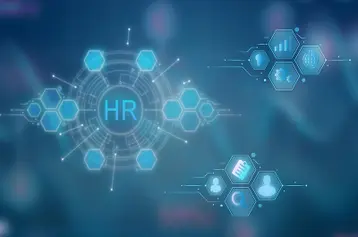
Table of contents
- 1.The Latest HR Technology Trends
- 2.AI and machine learning: Transforming HR functions
- 3.Technology to support hybrid work
- 4.Digital learning and employee training
- 5.The role of HR tech in employee well-being and mental health
- 6.Recruitment automation
- 7.Other HR technology trends to watch
- 8.How HR Tech Trends Are Influencing Business Leaders
Technology has become an essential tool for HR professionals. It helps to save time, reduces costs, and improves the accuracy of traditional human resources administrative tasks. It can help to manage processing payroll, administering benefits, keeping records, and complying with laws and regulations. In recent years, the role of HR has grown beyond the traditional tasks. Technology has helped to make this possible, playing a crucial role in today’s expanded HR functions.
Some of the current HR technology trends rely on advances in artificial intelligence and machine learning. Other technology trends are responses to changes in employee expectations, such as a desire for remote or hybrid work. Still others arise from the need to compete for talent in a tight labor pool.
Small and medium-sized businesses (SMBs) need to keep up with the latest in HR technology trends or risk their competitors passing them by. Incorporating the trends that best fit your company may raise productivity, increase efficiency, improve communications, and help attract and retain employees.
Keeping up with technology trends is not always easy for a SMBs. Technology systems can be too expensive for an SMB and often require specialized staff to operate. SMBs can still enjoy the substantial benefits that come with implementing some of the latest technology trends by partnering with a professional employer organization (PEO). PEOs have the resources to provide SMBs with the access they need to today’s cutting-edge HR technology.
The Latest HR Technology Trends
The latest trends in HR technology help companies attract, hire, and retain employees. Some of these trends are specifically aimed at the ways employees work, including the popularity of remote and hybrid work. Technology can also free HR staff from tedious administrative tasks, giving them more time to tackle strategic projects. Recent technology can also perform high-level data management, to help companies spot trends and make better decisions.
AI and machine learning: Transforming HR functions
Artificial Intelligence (AI) and machine learning help HR teams reduce their workload while increasing their company’s overall productivity. This is an area where technology is rapidly changing. Some applications of AI that HR teams may be using include:
- Answering employees’ questions.
- Assisting in recruitment.
- Identifying skills that the company needs and that recruiters should look for.
- Using HR data to guide business and employee-related decisions.
HR managers should be aware that in the near future, there is likely to be more employment-related rules and requirements of the use of AI to make hiring and other employment decisions.
Technology to support hybrid work
About 40% of full-time workers work exclusively from home or are hybrid workers, who work both at home and in the office. About twice as many of these employees are hybrid workers compared to purely remote workers.
Managing a hybrid workforce presents challenges. New technologies can help with talent management. HR managers can use software platforms to connect at the same time with employees who are on-site and at home. This facilitates training, skill-building, and communication.
As more work is done off-site, the way that employee performance is measured may have to change. Technology can provide new methods of performance management. It can help the HR team measure productivity in new ways, such as by assessing results.
Digital learning and employee training
With a cloud-based digital learning system, employees can easily access training materials from wherever they are, including at the office, at home, and on the road. Materials can include training videos, employee handbooks, and other HR documents. Training materials can be customized to meet the needs of the company and employees.
Enhanced management training is likely to be a popular trend. Technology will benefit managers in several ways, including:
- Helping managers develop the skills needed to deal with changing environments.
- Freeing up managers’ time by automating repetitive or less important tasks.
- Helping managers build relationships with remote workers to prevent at-home workers from burning out and to increase engagement and productivity.
- Analyzing data to pinpoint what managers need.
The role of HR tech in employee well-being and mental health
A Gallup study found that workers who were not thriving in their lives were 61% more likely to experience high levels of burnout. When employees get burned out, they are less productive and more likely to quit — both of which create expensive losses for their employer. Employers can help prevent these losses by investing in their employees’ well-being.
Devoting resources to employee well-being and mental health is also important for attracting new employees. These are important benefits that are popular with employees. Technology may be used to enhance employee well-being and mental health by:
- Generating data analytics that can help guide employers in providing a healthier environment for employees.
- Providing feedback that can help increase employee engagement.
- Enabling employees to access self-service portals to select benefits.
- Managing paid time off and sabbaticals.
- Offering clinician-guided chatbots that can use cognitive therapy techniques with employees.
Recruitment automation
If a company is doing extensive hiring, trying to keep track on paper of where each applicant is in the hiring process can become complicated. Information can get lost and potential employees overlooked. HR technology can help make it easy to automate the tracking process and make it more accurate. HR leaders can also use the system to help:
- Generate targeted ads to recruit candidates.
- Make the online application process quick, engaging, and easy to do on a phone or other mobile device.
- Make the workflow for the hiring process more efficient.
- Use videos to attract applicants, including videos made by current employees.
- Better inform existing employees of new opportunities.
Other HR technology trends to watch
- Internal talent marketplaces. These systems match internal employees with internal job openings, projects, learning opportunities, mentors, and other items. It helps them grow their careers and make them more visible to the company’s managers.
- Optimizing ROI from existing technology stacks. This trend involves companies getting the most out of the HR technology tools they already own rather than buying new systems. Companies following this trend are also combining the technology they have into integrated systems to reduce manual work, perform repetitive tasks, increase accuracy, and improve applicant and employee experience.
- Workforce analytics. HR analytics use the company’s data to provide sophisticated analyses that help HR teams make better decisions.
- Decentralized HR. In decentralized HR, human resources functions are placed in separate units that make decisions independently at the local level. They may use sophisticated technology processes.
How HR Tech Trends Are Influencing Business Leaders
There are about twice as many unfilled jobs as there are unemployed workers. Businesses must compete for top talent. Companies that don’t use technology to help guide and streamline the recruitment and hiring process put themselves at a disadvantage.
Technology is also playing an increasing role in providing training that benefits both employees and employers. It also helps to make it easier to communicate with the substantial portion of the workforce that is working at home at least some of the time. Technology helps keep remote employees engaged and feeling included even while they are physically apart.
Artificial intelligence, machine learning, and data analytics are at the frontier of technological progress. Because they are evolving so rapidly, to get the most use out of them, companies will need the guidance of people with expertise in these areas.
Many SMBs are not going to be able to adopt all these trends on their own. They don't have HR departments with the required expertise, and it can be prohibitively expensive to get an advanced technology system for their own private use.
Professional employer organizations (PEOs) such as TriNet may be the solution. PEOs work with many client businesses, and economies of scale give them access to sophisticated technology systems that SMBs may have harder time to engage on their own. Choosing TriNet as the PEO provider gives customers access to experts and support and HR technology so customers can adopt the technology trends that will most benefit their business.
This communication is for informational purposes only, is not legal, tax or accounting advice, and is not an offer to sell, buy or procure insurance.
This article may contain hyperlinks to websites operated by parties other than TriNet. Such hyperlinks are provided for reference only. TriNet does not control such web sites and is not responsible for their content. Inclusion of such hyperlinks on TriNet.com does not necessarily imply any endorsement of the material on such websites or association with their operators.

TriNet Team
Table of contents
- 1.The Latest HR Technology Trends
- 2.AI and machine learning: Transforming HR functions
- 3.Technology to support hybrid work
- 4.Digital learning and employee training
- 5.The role of HR tech in employee well-being and mental health
- 6.Recruitment automation
- 7.Other HR technology trends to watch
- 8.How HR Tech Trends Are Influencing Business Leaders





